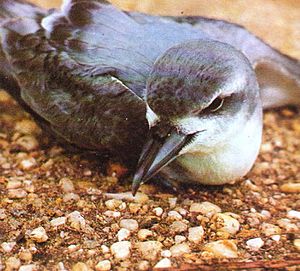Salvin's prion facts for kids
Quick facts for kids Salvin's prion |
|
|---|---|
 |
|
| Conservation status | |
| Scientific classification | |
| Genus: |
Pachyptila
|
| Species: |
salvini
|
| Subspecies | |
|
|
The Salvin's prion (also called the medium-billed prion) is a type of seabird. It belongs to the petrel family, which is known as Procellariidae. Its scientific name is Pachyptila salvini. These birds are small and spend most of their lives flying over the ocean.
Contents
About Salvin's Prion
Salvin's prion is part of a group of birds called prions. Prions are small seabirds that mainly eat tiny ocean creatures called zooplankton. They are also related to other birds in the Procellariiformes order, like albatrosses and shearwaters.
Special Features of Prions
Birds in the Procellariiformes group have some unique features:
- They have special nose tubes called naricorns on their upper beak. For prions, these nostrils are right on top of their beak.
- Their beaks are made of 7 to 9 hard plates.
- They can make a special stomach oil. This oil is stored in their stomach and is full of energy. They use it to feed their chicks or for long flights. It can also be sprayed at predators to defend themselves.
- They have a salt gland above their nose. This gland helps them get rid of extra salt from the ocean water they drink. It releases a salty liquid from their nose.
What's in a Name?
The name Pachyptila comes from ancient Greek words. Pakhus means "thick" or "stout," and ptilon means "a feather."
The word "prion" also comes from Greek, from priōn, meaning "a saw." This refers to the saw-like edges on the bird's bill. These edges help them filter food from the water.
The species is named after Osbert Salvin, a British expert on birds.
What Salvin's Prion Looks Like
Salvin's prion is a small bird, about 29 centimeters (11 inches) long. It has grey and white plumage (feathers) and a blue bill. Like the broad-billed prion, it has special comb-like structures called lamellae inside its bill. These lamellae act like a filter to strain small food items from seawater.
Life and Habits
Reproduction and Breeding
These small prions gather in large groups called colonies to breed. They nest on several subantarctic islands in the southern Indian Ocean. They usually visit their nests at night to avoid predators like skuas.
They dig burrows in the soil to hide their nests. Before laying eggs, they regularly visit their burrows for several months. A single egg is laid in November or early December. Both parents take turns sitting on the egg for about 50 days until it hatches. After the chick hatches, both parents feed it. The young bird is ready to fly (fledge) about 60 days later.
What They Eat
Salvin's prions mostly eat small ocean creatures like amphipods and krill. They also sometimes eat small fish and squid. They get their food by filtering water through their bills, grabbing items, or skimming the surface of the water.
Where They Live
Salvin's prion mainly breeds on Île aux Cochons in the Crozet Islands. It's estimated that about four million pairs breed there. Other places where they breed include Prince Edward Island, St Paul Island, and Amsterdam Island. When they are not breeding, they can be found flying over the ocean from South Africa all the way east to New Zealand.
Conservation Status
Salvin's prion is not currently considered in danger of extinction. Even though their numbers have gone down on some islands where animals like rats and feral cats were brought in, the total world population is still very large, around 12 million birds. Because of this, they are classified as a species of Least Concern.
See also
 In Spanish: Pato petrel de Salvin para niños
In Spanish: Pato petrel de Salvin para niños



